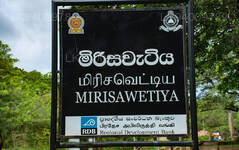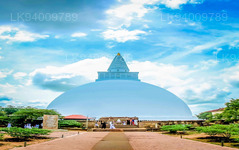
アヌラーダプラの宿泊施設
아누라다푸라는 스리랑카 북중부 지방에 속합니다. 아누라다푸라는 스리랑카의 고대 수도 중 하나로, 잘 보존된 고대 스리랑카 문명 유적지로 유명합니다. 현재 유네스코 세계문화유산으로 지정된 이 도시는 스리랑카의 현재 수도 콜롬보에서 북쪽으로 205km 떨어져 있습니다.
Mirisawetiya (මිරිසවැටිය)
More than 2100 years old, Mirisawetiya is one of the most ancient Dagabas in Sri Lanka . Built by the great king Dutugemunu, this Maginficant Structure is a must see for any visitor to the sacred city of Anuradhapura .
It is believed that the great king Dutugemunu made many wishes here that have come true during his lifetime.
King Dutugemunu built it as a Dagoba of the “Mahavihara” fraternity but as the monks started living there, it sees that Mirisawetiya developed as a separate monastery.
The Creator of Mirisawetiya
It is rumored that the King once forgot to offer a pod of chillie to the Monks before eating . As a token of apology, it is said that the King named the Dagaba Mirisawetiya.
Another theory is that ‘Mirisawetiya‘ is the ancient name of the village on which the dagoba was built (Ref: “Ancient Anuradhapura by Prof. Anuradha Seneviratna”).
The Dagaba’s Period of Ruin.
The next centuries saw the complete disintegration of the dry zone civilization which lead to the shifting of the Rajarata Kingdom . For the next seven hundred years, the Dagaba lay in ruins.
When the Englishman Henry Parker saw the Mirisawetiya in 1873, he saw nothing but a mound covered with large trees and tangled undergrowth. Anuradhapura’s first government agent J.F Dixon , with the help of Mr Smither, first cleared the area surrounding the Dagaba. In the process Smither examined the dagaba and found a magnificent ?Vahalkada?(frontpiece) and measured the dagaba at a height of 200 feet. At that time they found an image house to the west of the Dagaba. Later on Dixon became the president of the Royal Asiatic Society’s Ceylon Branch and with the help of a Rs. 1000 donation from the Society, enabled excavations around the Dagaba under the supervision of Mr Burrow.
The unparallel artistic value of the “Vahalkada” is said to be the main reason that so much notice was taken of Mirisawetiya.
During the excavations they hoped to find image houses similar to what they found on the Western side, on the other three sides too . However, when they found that the image house on the eastern side was destroyed, they got discouraged and stopped the work.
Excavations started again in 1883 and at that time they found the ruins of two image houses in the northern and southern sides of the dagaba.
Using a grant obtained from the King of Siam (Now Thailand),for Rs. 12,500, a renovation was begun in 1888 but could not be completed.
아누라다푸라 지구 소개
아누라다푸라는 스리랑카 북중부 지방에 속합니다. 아누라다푸라는 스리랑카의 고대 수도 중 하나로, 잘 보존된 고대 스리랑카 문명 유적지로 유명합니다. 현재 유네스코 세계문화유산으로 지정된 이 도시는 스리랑카의 현재 수도 콜롬보에서 북쪽으로 205km 떨어져 있습니다. 신성한 도시 아누라다푸라와 그 주변에는 수많은 유적이 있습니다. 유적은 다고바, 수도원, 그리고 포쿠나(연못)의 세 가지 유형의 건물로 구성되어 있습니다. 이 도시는 고대 세계에서 가장 복잡한 관개 시스템을 갖추고 있었으며, 국가의 건조 지대에 위치해 행정부는 토지에 관개를 위해 많은 탱크를 건설했습니다. 대부분의 민간인은 싱할라족이며, 타밀족과 스리랑카 무어족이 이 지역에 거주합니다.
북중부 지방 소개
북중부 지방은 이 나라에서 가장 큰 지방으로 전체 국가 면적의 16%를 차지했습니다. 북중부 지방은 폴로나루와와 아누라다푸레라는 두 개의 지구로 구성되어 있습니다. 아누라다푸라는 스리랑카에서 가장 큰 지구입니다. 면적은 7,128km²입니다. 북중부 지방은 투자자들이 사업을 시작할 수 있는 수많은 잠재력을 가지고 있으며, 특히 농업, 농업 기반 산업 및 축산 분야가 그렇습니다. 북중부 지방 주민의 65% 이상이 기초 농업 및 농업 기반 산업에 의존합니다. NCP는 이 지방에 중대형 탱크가 3,000개 이상 있기 때문에 "웨우 벤디 라제"라고도 불립니다. 스리 마하 보디야, 루완웰리 세야, 투파라마 다게바, 아바야기리 수도원, 폴로나루와 랑코트 웨헤라, 란카티레이크가 두렵습니다.

















